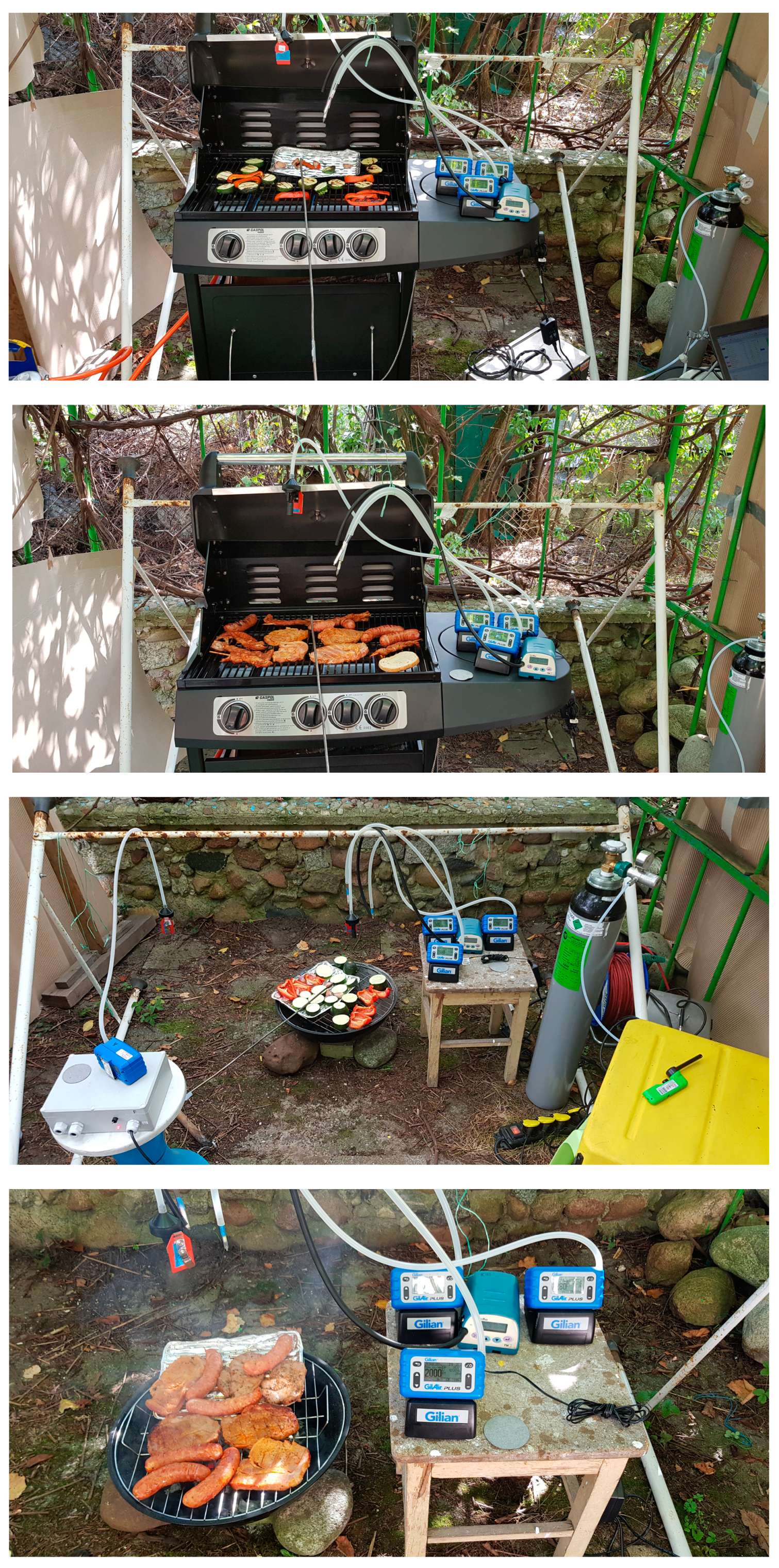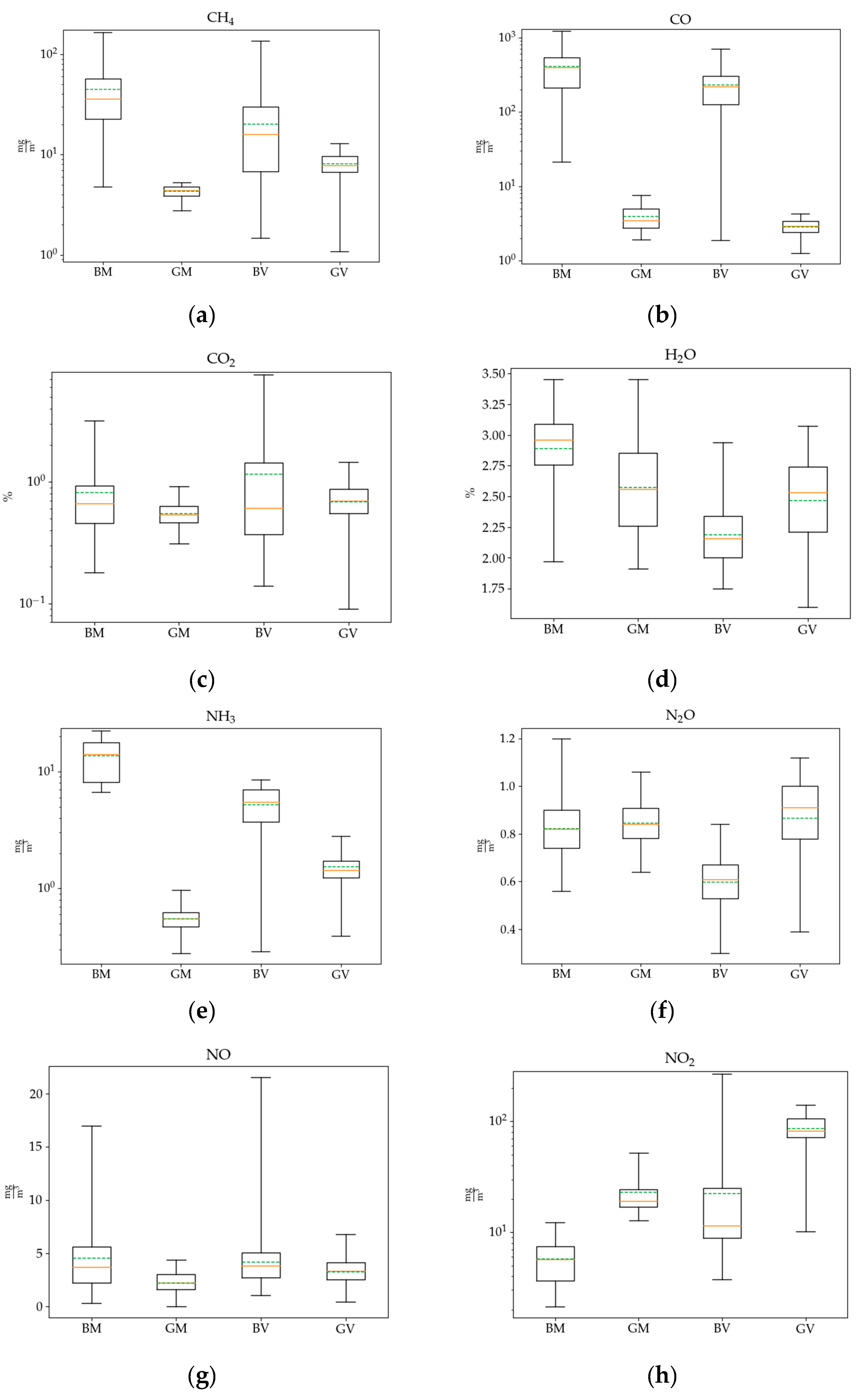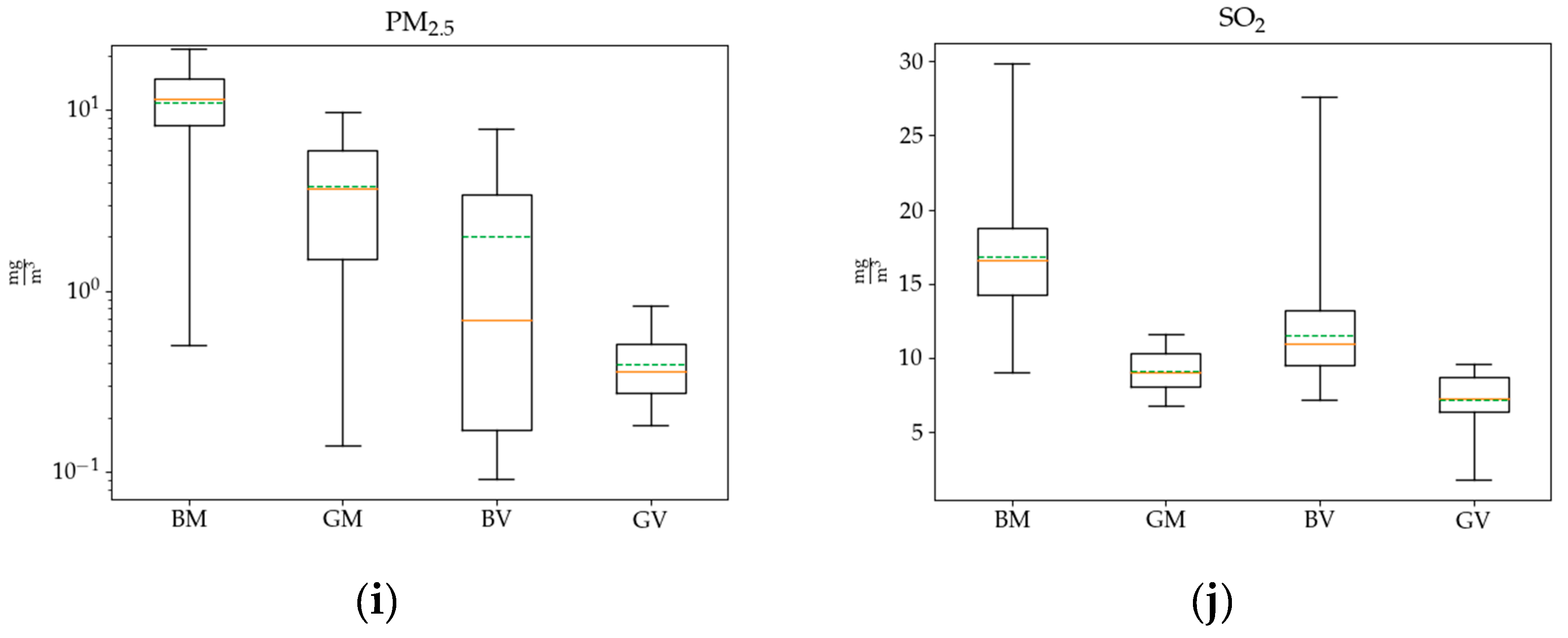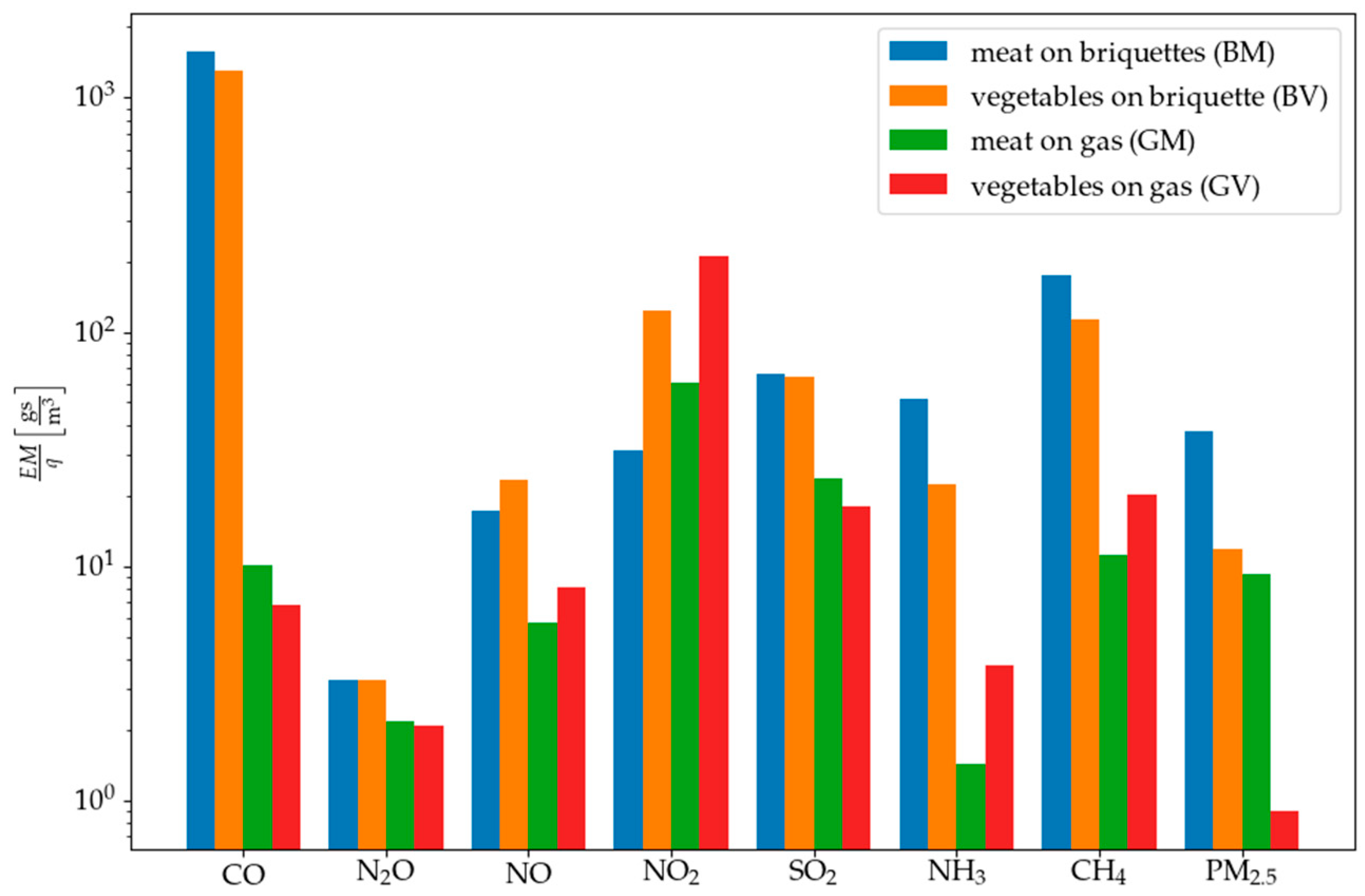1. Introduction
According to the data of The National Centre for Emissions Management (KOBiZE), the main source of air pollution in Poland is the so-called low-stack emission, i.e., the emission of harmful gases and particles from emitters not exceeding 40 m above the ground, resulting mainly from combustion processes in local stoves/boilers rooms and domestic furnaces and fireplaces, i.e., the municipal and households sector [
1,
2]. Due to lower price and widespread access, coal, charcoal, and wood are mostly used in domestic furnaces, and in mining regions also brown coal, silts, and fleets [
3]. In Poland, the problem of low-stack emissions is aggravated by a large number of coal stoves, burning of low-quality coal, wood, and sometimes even municipal waste, the use of inefficient and old-type boilers with manual stoking and natural draft, and a long heating season (from October to March) [
3,
4]. The phenomenon of emissions from the municipal and households sector occurs mainly in the areas of single-family housing and applies to the whole year. The most unfavorable situation, however, appears in winter, when there is the highest heat demand. The scale of the problem is proved by seasonal changes of particulate matter, polycyclic aromatic hydrocarbons (PAH), and gaseous pollutants (NO
x, SO
2) levels [
5,
6,
7,
8,
9].
Low-stack emission is also a significant source of air pollution in many regions worldwide, including Canada, the United States, Australia, Ireland, Austria, Italy, where it is mainly associated with wood burning in fireplaces and wood burning stoves [
10,
11,
12,
13,
14,
15,
16,
17]. Fireplaces are inefficient combustion devices with high uncontrolled excess air rates and without any sort of secondary combustion, resulting in a significant quantity of unburnt combustibles. Several studies indicate that burning in fireplaces is accompanied by the emission of a wide spectrum pollutants, i.e., fine and coarse particles (particulate matter—PM), carbon monoxide (CO), carbon dioxide (CO
2), nitrogen dioxide (NO
2), polycyclic aromatic hydrocarbon (PAHs), and volatile organic compounds (VOCs) [
13,
15,
16,
17,
18,
19,
20]. Research by Guo et al. [
13] conducted in 27 randomly selected Irish houses, found that concentrations of CO and particulate matter inside homes with fireplaces were several times higher than the average concentrations in a normal house with central heating. Alves et al. [
15] who compared fine particle emission from cast iron woodstove operated manually in batch mode, with handheld control of combustion air and from a traditional Portuguese brick open fireplace operated manually in batch mode, with no control of combustion air, showed that PM
2.5 emission factors (g × kg
−1 fuel burned, dry basis) were higher for the fireplace and the woodstove.
Another, increasingly important source of atmospheric air pollutants including PM, carbon monoxide (CO), nitrogen oxides (NO
x), volatile organic compounds (VOCs), carbonyls, trace metals, and polycyclic aromatic hydrocarbons (PAHs) are barbecue grills powered by lump charcoal and charcoal briquettes [
21,
22,
23,
24,
25,
26,
27]. According to the reports of Hearth, Patio and Barbecue Association almost 64% of U.S. adults own a grill, while in Canada—about 72%. More than half of them use a charcoal grill [
28]. About 75% of owners grill during the whole year, at least 1–2 times per week, especially during birthday parties, camping trips, holidays, or sports events. In Poland, according to the research conducted by the TNS Polska (Public Opinion Research Centre) in 2015, the barbecue season lasts from late spring to early autumn. Then, 30.7% of Poles grill at least once a week, and another 43.6% 2–3 times a month. Herein, the vast majority also use traditional charcoal or charcoal briquette fired grills for this purpose. In Poland, the problem of air pollution due to grilling occurs especially in resorts, recreation places, i.e., clearings outside the city, or on beaches with designated places for this purpose. Air pollutant emissions from grilling may be a significant source of health exposure, and the mechanism of the impact of pollutants on human health may be similar to emissions from the combustion of solid fuels in household furnaces (coal boilers/stoves or fireplaces), except that the emissions from the grill takes place at the level of the human respiratory tract, and the emission from the boiler—10–40 m above the ground. Preliminary measurements results of air pollutants emitted from selected grill furnaces [
24] showed that this method of food preparation favors the emission of significant amounts of solid particles, which, especially when using traditional fuels (charcoal and briquette), contain groups of polycyclic aromatic hydrocarbons (PAHs) in high concentrations. Research on pollutant emissions related to grilling mainly concerns indoor PM and PAHs concentrations during grilling in residences and restaurants [
23,
29,
30,
31,
32], as well as dietary exposure, and health risk related to polycyclic aromatic hydrocarbons in grilled meals [
24,
33,
34,
35,
36,
37]. There is much less research to investigate the influence of outdoor barbecue smoke on atmospheric air quality [
26,
27,
38].
Investigations of Rahman and Kim [
39] indicate that charcoal-fueled grills are also a source of offensive odorants, including aldehydes, VOCs, carbonyls, reduced sulfur compounds, and ammonia. The emission of odorants also accompanies the burning of wood in domestic stoves [
40]. While emissions from a stack appear on the Environmental Protection Act (EPA) [
41] list of factors that can cause odors, grilling is not included in this list. A relatively small number of publications on the subject of odors accompanying burning in grills and stoves allows to conclude that this problem is not fully understood, which is the result of the high level of complexity of research in this subject, significant costs of their conduct, and the lack of uniform legal regulation for odor standards. The EU suggests introducing local regulations in this matter, therefore the permissible concentrations of odorous substances in most EU countries result from internal, national legal acts regulating the permissible concentrations of air pollutants. In Germany, France, the Netherlands, Great Britain, Japan, the United States, and Canada, legal solutions are available covering both regulations on emission standards, limit levels, as well as research methods and modelling of odor spread, as well as nuisance assessment using sociological research. However, they mainly focus on the emission of odorous substances in industry and agriculture, as well as in other branches of the economy. The problem of air pollution and odors accompanying grilling and burning in domestic stoves is becoming more and more noticeable. The nuisance of air pollution and odors accompanying the use of grills, wood-fired stoves is evidenced by solutions introduced in some districts, housing communities, public places prohibiting grilling or allowing the use of gas or electric grills. In some Polish provinces, a periodic ban on burning in fireplaces is also introduced, especially in the winter season when the risk of smog episodes appearance increases.
The aim of this study was to present, analyze, and discuss the results of experimental measurements, in which the scope of the first studies [
24] was extended to include the analysis of the concentrations of particulate matter and selected gaseous pollutants emitted from grill furnaces powered by charcoal and gas. For comparative purposes, the results of measurements of pollutants in emission streams generated during the combustion of solid fuels in selected domestic heating devices are also presented. The experiment was conducted in Warsaw because the emission structure in this city is the closest to the emission structure in other European cities.
3. Results and Discussion
We analyzed the concentration data collected during the experiment.
Figure 2 presents the matrix of 10 plots, one for each analyzed substance. For each substance, four data sets are presented—the concentrations above the grill hearth during the preparation of meat (M) or vegetables (V) on charcoal briquette-fueled grill (B) or gas-fueled grill (G). The data sets were typically 170 samples long. The concentrations of pollutants and green-house gases exhibited high variability depending on the type of fuel burned and the kind of prepared meal (meat vs. vegetables). Concentrations of almost all of the analyzed substances, except for NO
2, were much higher during the preparation of meals with the use of charcoal briquette than with the liquid propane. The most pronounced differences concern CO concentrations, which for meat and vegetables, respectively, were 155 and 189 times higher during briquette combustion than during gas combustion, then NH
3 (36-times for meat, six-times for vegetables), CH
4 (15-times for meat, five-times for vegetables), and PM
2.5 (four-times meat, 13-times vegetables). Although the results present different variability, we observed two main patterns in concentrations: BM > BV > GM > GV or BM > BV > GV > GM (for example for CO) and BM > GM > BV > GV (for example for PM
2.5 and in the inverse order for NO
2). The first pattern suggests that the concentration is mainly influenced by the type of fuel, and the second suggests the type of grilled material as the main cause of emission. We found that the first pattern is typical for the concentrations of CH
4, CO, NH
3, SO
2, while the second one for PM
2.5 and NO
2 (reversed order).
We performed the Shapiro–Wilk test to check which of the 40 data sets are taken from the normal distribution. The result showed that only five sets represent normal distribution for α = 0.1: PM
2.5 BM, CO GV, NO GV, NO
2 BM, and NH
3 GM (for details see
Appendix A). We decided to use only the Mann–Whitney U test for a comparison of four data sets in each of the 10 groups. The test showed that only eight pairs of sets reveal similarities at α = 0.01 (detailed results of tests are presented in
Appendix A). These are for H
2O%: GM-GV, for CO
2% BM-BV, BM-GV, GM-BV, BV-GV, for N
2O BM-GM, for NO BM-BV, BM-GV.
We calculated the total emissions according to Formula (1). The emissions per unit flow are presented in
Figure 3. During the combustion of briquettes, the highest emissions of CO (1299–1578 g × s/m
3) and CH
4 per unit flow (112–173 g × s/m
3) were noted. High emissions per unit flow, which were observed for carbon monoxide, may indicate an incorrect combustion process. CO is a product of incomplete combustion, generally associated with the smoldering phase. Burning briquettes in inefficient devices such as grills generate high levels of CO due to relatively low temperatures and a reduced or almost no visible flame above the layer [
59]. Methane is an important component released during biomass combustion [
60]. In the case of gas-fueled grills, the highest emission per unit flow was recorded for NO
2 (60–210 g × s/m
3). NO
2 emissions from gas combustion are mostly associated with thermal and prompt formation, whereas the dominant mechanism of NO
2 formation during the combustion of briquettes is from the fuel nitrogen content since the temperatures achieved in grills are usually too low for prompt and thermal formation [
61,
62]. Summarizing, we see similar tendencies as in the concentration box plots (
Figure 2). The order of the emissions of CO, PM
2.5, SO
2, and N
2O is as follows: BM > BV > GM > GV. It means that the total emission is firstly dependent on fuel type and secondarily on the type of grilled products. In case of NO, NH
3, and CH
4 the situation is different and fuel type has a crucial influence on emission (i.e., B > G) while it was not possible to determine the impact of the kind of grilled dishes. The total emission of NO
2 during the grilling shows that there is no clear relation of emission to dish or fuel.
The total emissions of pollutants and gases observed over the charcoal briquette-fueled grill hearth are comparable to that reported by Vicente et al. and Yu et al., who tested the emission of the gaseous pollutants and particulate matter (PM
2.5) from charcoal combustion in a typical brick barbecue grill [
27,
62]. There are few data on pollutant emissions depending on the type of meal being prepared. The results in this regard were presented in [
63], where it was shown that marinated meat yielded an increased total VOC and total PM emissions compared to non-marinated meat and there were no significant differences in emission rates between chicken and beef.
Table 1 summarizes the annual emissions of individual pollutants released during meat and vegetables grilling on two types of grills (charcoal briquette and gas-fueled) and the annual emissions related to the combustion of coal and wood in three types of stoves/boilers (bio-mass, old type, Ecoproject stove) taking into account the quality of the fuel (high vs. poor).
Table 2 compares the emissions from briquette and gas-fueled grills with the total emissions from three types of stoves and with the data from the Statistics Poland [
54] on emissions of the analyzed pollutants from households. In addition,
Table 2 shows the percentage of individual pollutants from grills in the annual emission resulting from combustion in the above-mentioned stoves/boilers. According to the data presented in the
Table 1 and
Table 2, CO has the highest mass share in the total mass of pollutants emitted during the year due to grilling, while PM
2.5 the lowest. In case of wood and coal combustion in stoves, the largest mass share also belongs to CO, and the lowest to NO
x (in case of old type stoves) and PM
2.5 (in case of Ecoproject stoves), but the authors did not reach the data on NH
3 and CH
4 emissions related to combustion in different kind of stoves. Emissions of pollutants released by grilling account for a small percentage (2–8%) of the annual emissions of pollutants resulting from combustion of coal and wood in stoves. However, it should not be interpreted that the emissions of pollutants from the grilling processes are negligible. It results from the intensive use of domestic stoves and boilers herein and the associated high PM and gaseous emissions [
1]. The comparison of the calculation data on emissions from grills and boilers with the statistical data of Statistics Poland and the fact that they are of the same order of magnitude confirms the justifiability of the assumptions made in the calculations. Although the total emissions from grills is definitely lower compared to the annual emissions from stoves/boilers, it can be treated as a significant cause of seasonal changes in air quality, i.e., in the grill season, which in Poland lasts from spring to early autumn. Frequent grilling can deteriorate the air quality, especially at campsites, single-family houses, holiday cottages estates, suburban clearings, arcades with restaurants, or beaches with a designated barbecue area, where dozens of outdoor barbecue events take place almost every day. It can also be an important cause of health exposure and the resulting adverse health effects, which in the case of air quality are of great importance in Poland [
64,
65]. Barbecue cooking can have a significant influence on ambient air quality due to the uncontrolled emissions and subsequent diffusion and transport mechanism with the wind [
62,
66]. It should be noted that the study did not take into account the concentrations of other pollutants released during grilling, e.g., polycyclic aromatic hydrocarbons, or trace metals—the concentration of which during grilling were higher compared to the ambient atmosphere according to research [
23,
27]. In the case of emissions from home furnaces and stoves, the combustion process is much more refined and controlled. Air quality management is not accidental as it is when burning solid fuel on a grill. In modern stoves/boilers (meeting the requirements of the Ecoproject Directive), not only the value of the excess air coefficient is controlled, but also its distribution in the furnace chamber. As a result, PM
2.5, CO, NO
x, SO
2 emissions are significantly lower than in the case of burning fuel on the grill (
Table 1 and
Table 2). The PM2.5 concentration was calculated according to [
51].
Obtained results indicate that further studies on the concentrations of various pollutants released during grilling and the assessment of health exposure should be investigated. The calculations described above are based on emission data only for Poland, where the measurements were carried out. In future research, based on the data on low-stack emissions in other countries, e.g., UK, Ireland, Germany [
67,
68], and based on barbecue habits of their citizens, a similar analysis could be carried out using the methodology proposed in the manuscript.











